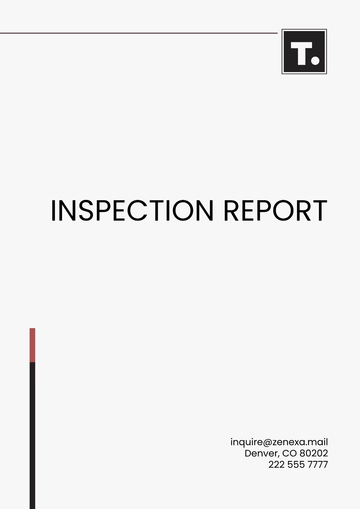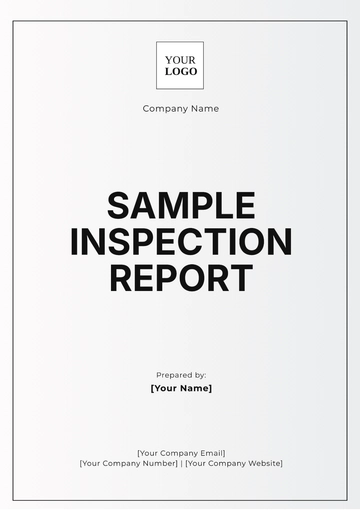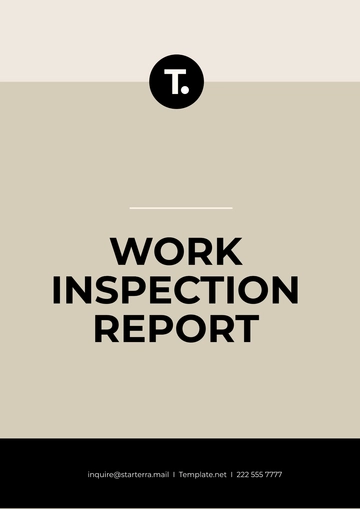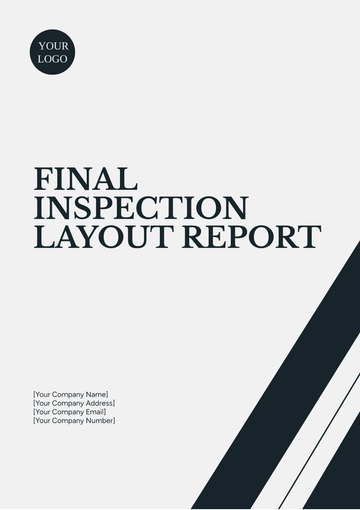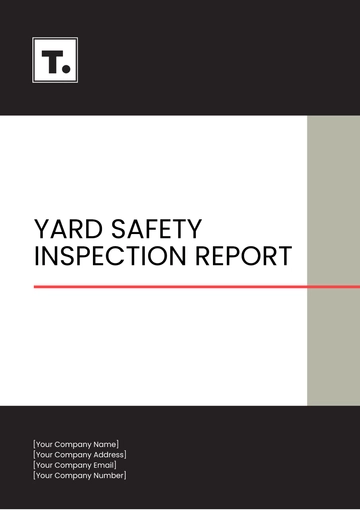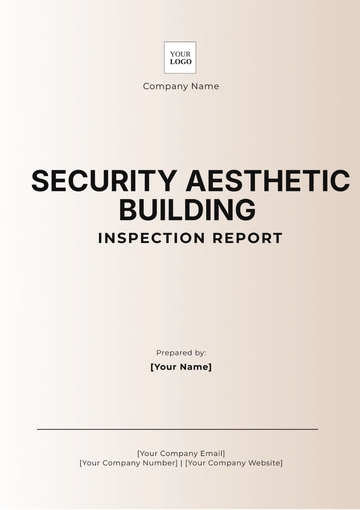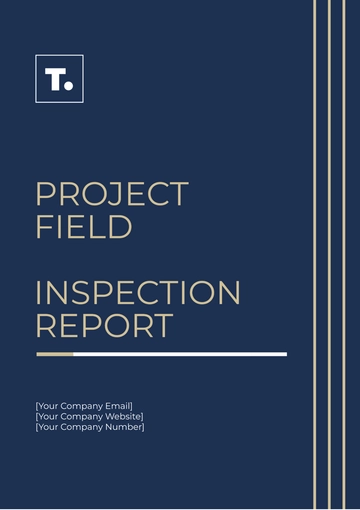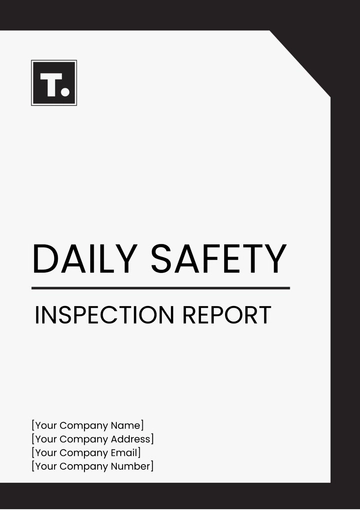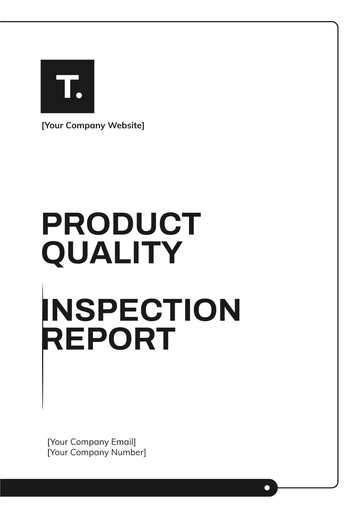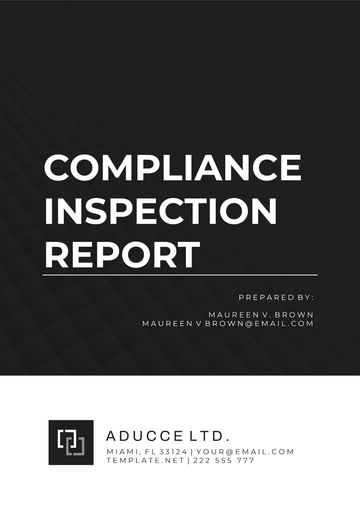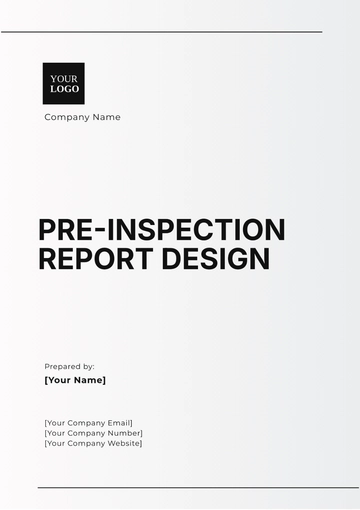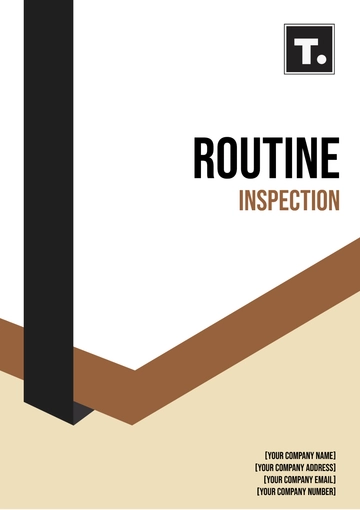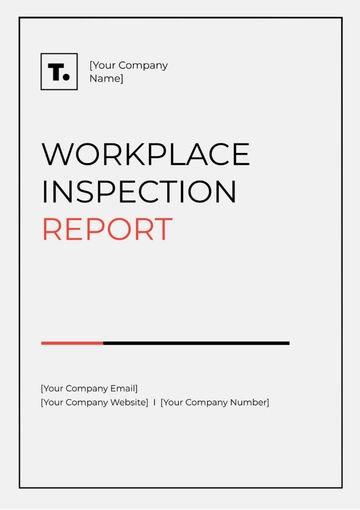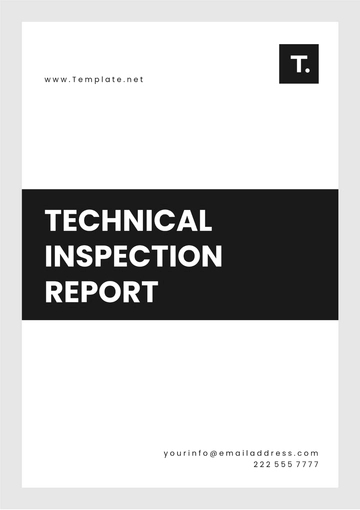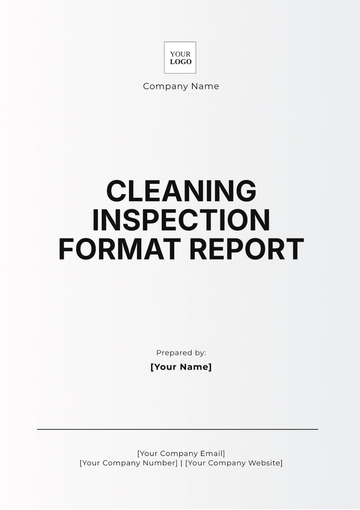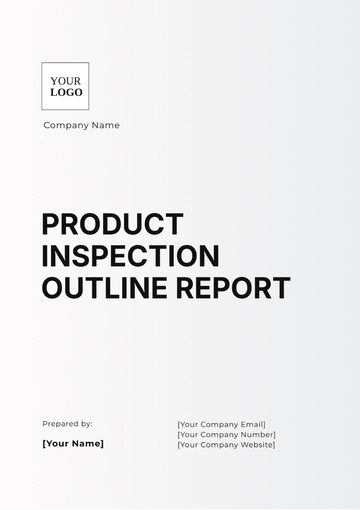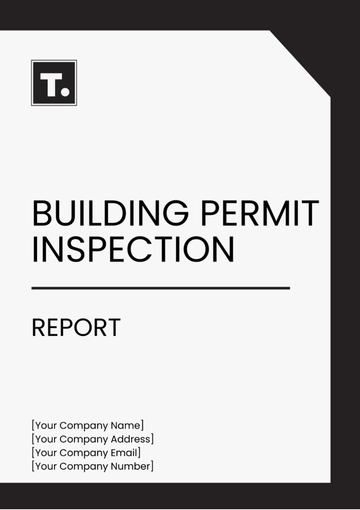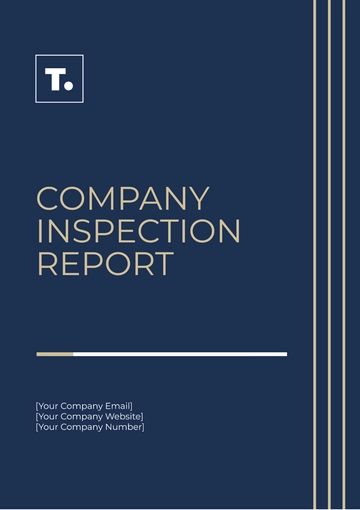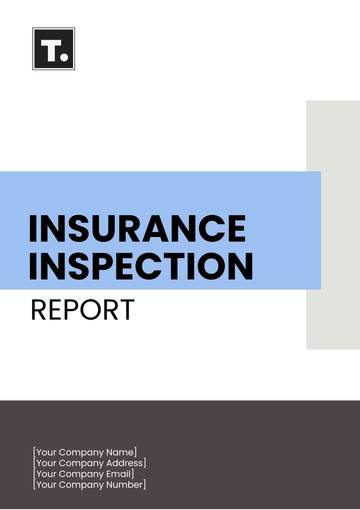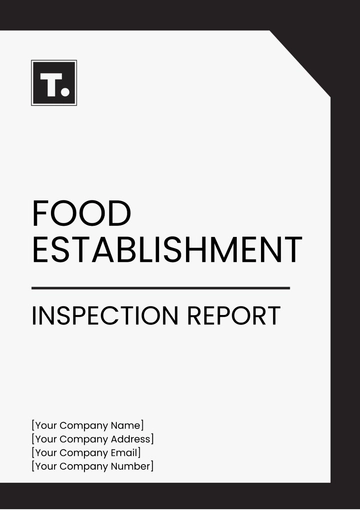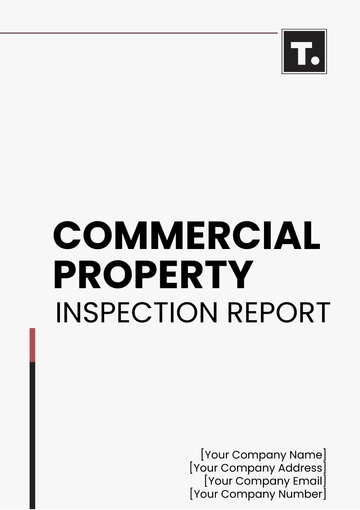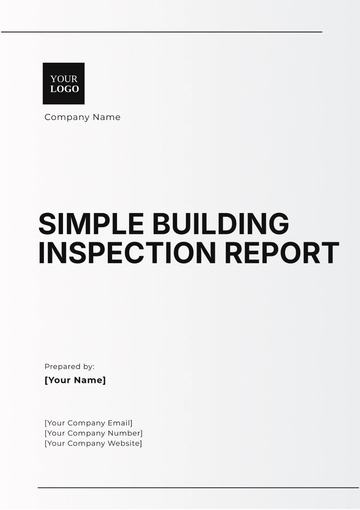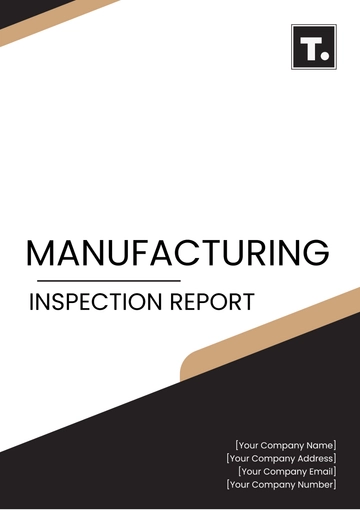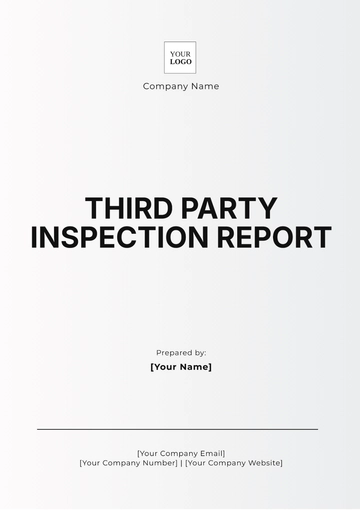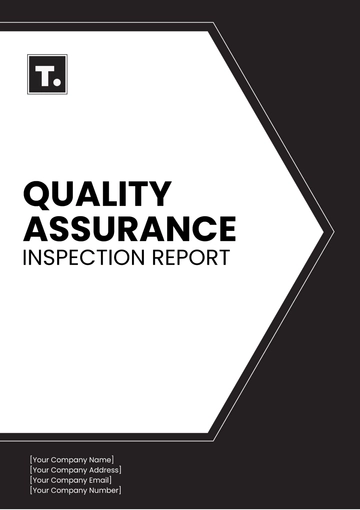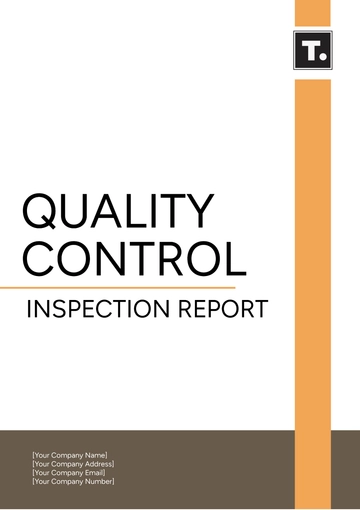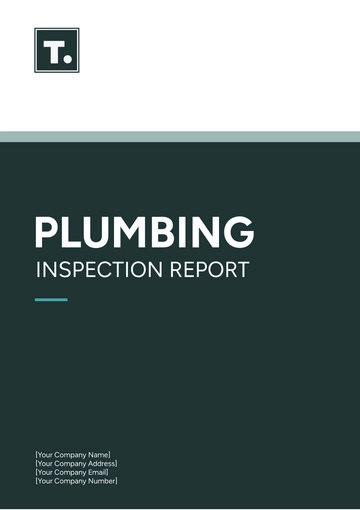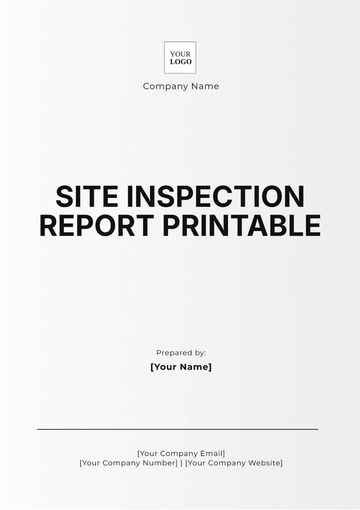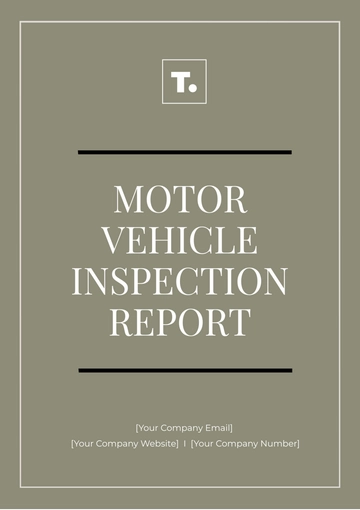Free Hotel Inspection Report
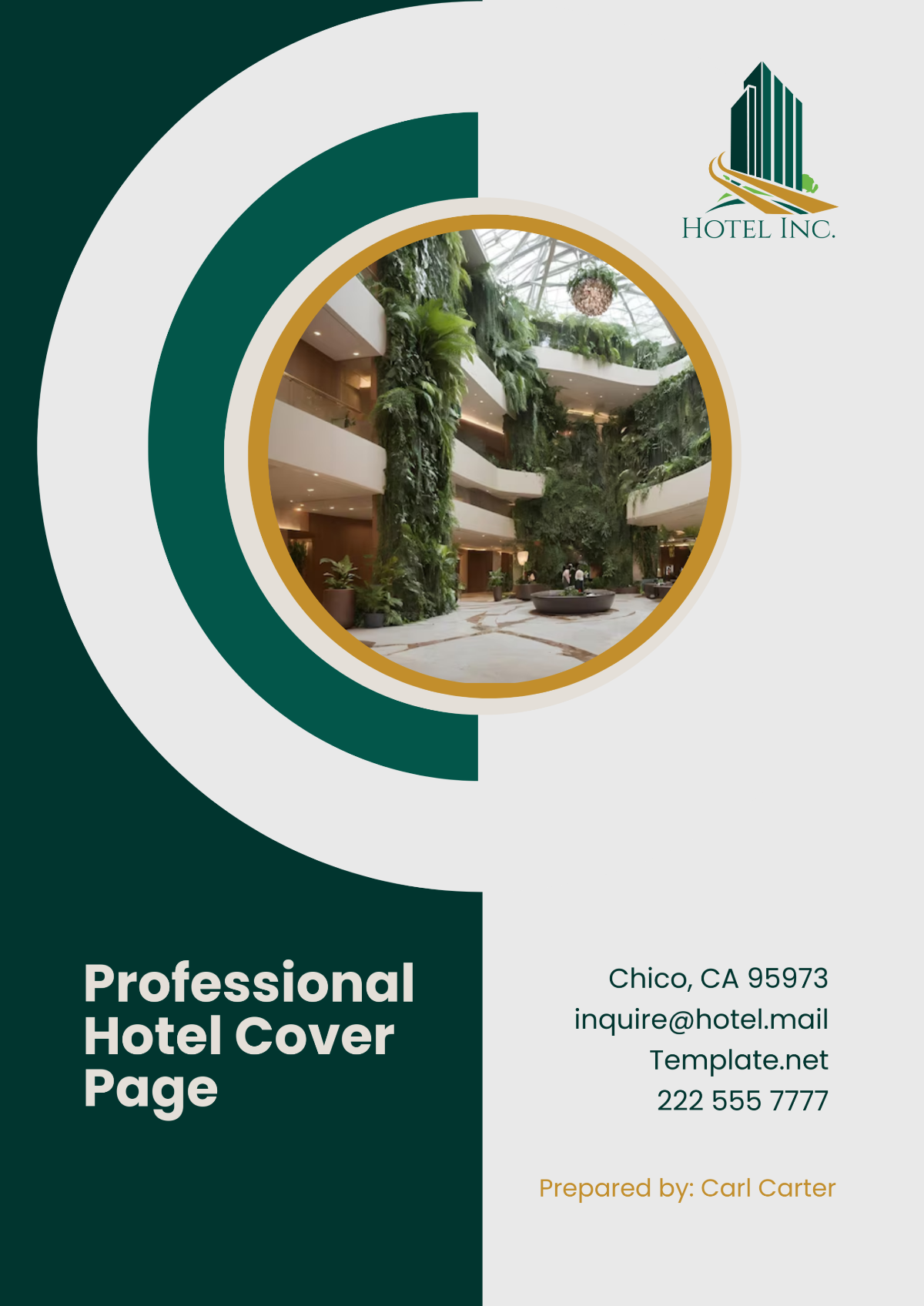
I. Introduction
A. Purpose of the Report
Ensure Compliance: The primary purpose of this report is to ensure that the hotel complies with all relevant health and safety regulations. This compliance is critical for the legal operation and reputation of the hotel.
Enhance Safety Protocols: The report aims to identify areas where safety protocols can be enhanced. Improved protocols will contribute to a safer environment for both guests and staff.
Risk Mitigation: Another purpose is to mitigate potential risks by identifying and addressing safety concerns. Proactive risk management helps prevent accidents and emergencies.
Promote Continuous Improvement: The report seeks to promote continuous improvement in health and safety standards. Ongoing enhancements ensure that the hotel remains a leader in guest safety.
B. Scope of the Inspection
Comprehensive Coverage: The inspection covers all areas of the hotel, ensuring no aspect is overlooked. This comprehensive approach helps identify any potential safety issues.
Time Frame: Conducted over a period of one week, the inspection allows for thorough assessments. Adequate time ensures detailed and accurate findings.
Focus Areas: The inspection focuses on guest rooms, public areas, dining facilities, kitchen, and staff areas. Targeting these areas ensures all critical points of contact are evaluated.
Inspection Team: A dedicated team of inspectors with expertise in health and safety conducted the inspection. Their expertise ensures a high level of scrutiny and accuracy.
C. Methodology
Visual Inspections: Visual inspections were performed to identify visible safety hazards. This method helps detect obvious issues that need immediate attention.
Interviews: Staff members were interviewed to understand the implementation of safety protocols. These interviews provide insights into daily practices and compliance.
Document Review: Safety logs, maintenance records, and compliance certificates were reviewed. Reviewing these documents verifies that all safety measures are documented and up to date.
Testing: Safety equipment, such as fire alarms and sprinklers, was tested to ensure functionality. Regular testing is essential to confirm that safety systems are operational.
II. Fire Safety
A. Fire Detection and Alarm Systems
The following table details the current status of fire detection and alarm systems in the hotel:
Item | Status |
|---|---|
Smoke Detectors | Fully Functional |
Fire Alarms | Fully Functional |
Emergency Lighting | Not Fully Functional |
Sprinkler Systems | Fully Functional |
Smoke Detectors: All smoke detectors are fully functional, ensuring early detection of smoke and fire. Regular maintenance checks are performed to guarantee their operational status.
Fire Alarms: The fire alarms are in excellent working condition, providing immediate alerts in case of fire. Routine testing is conducted to ensure reliability.
Emergency Lighting: Emergency lighting systems are not fully functional, with several units requiring maintenance or replacement. Inadequate emergency lighting can hinder evacuation during power outages.
Sprinkler Systems: The sprinkler systems are operational and tested regularly. They play a vital role in controlling and extinguishing fires.
Having fully functional fire detection and alarm systems is critical to the safety of our guests and staff. However, the emergency lighting issue must be addressed promptly to ensure effective evacuation during emergencies.
B. Evacuation Procedures
Evacuation Drills: Regular evacuation drills are conducted to ensure staff and guests are familiar with emergency exits and procedures. These drills are crucial for maintaining preparedness.
Exit Signage: Clearly marked and illuminated exit signs are installed throughout the hotel. Proper signage is essential for guiding guests to safety.
Emergency Exits: All emergency exits are unobstructed and accessible. Regular checks ensure that exits remain clear and functional.
Evacuation Plans: Detailed evacuation plans are displayed in guest rooms and common areas. These plans provide critical information for safe evacuation.
Effective evacuation procedures are essential for ensuring the safety of all occupants during an emergency. Regular drills and clear signage are key components of our safety strategy.
III. Kitchen and Food Safety
A. Hygiene Standards
The following table outlines the hygiene standards observed in the hotel's kitchen:
Item | Compliance Status |
|---|---|
Food Storage | Compliant |
Cleanliness of Work Surfaces | Compliant |
Personal Hygiene of Staff | Compliant |
Pest Control Measures | Compliant |
Food Storage: Proper food storage practices are strictly adhered to, ensuring food safety and preventing contamination. Regular inspections verify compliance.
Cleanliness of Work Surfaces: Work surfaces are maintained in a clean and sanitized condition. Cleaning schedules and checklists ensure that hygiene standards are met.
Personal Hygiene of Staff: Staff members follow strict personal hygiene protocols, including regular hand washing and wearing appropriate attire. Training programs reinforce these practices.
Pest Control Measures: Effective pest control measures are in place, including regular inspections and treatments. These measures are vital for maintaining a safe and sanitary kitchen environment.
Maintaining high hygiene standards in the kitchen is crucial for preventing foodborne illnesses and ensuring the safety of our guests. Regular inspections and staff training are essential components of our food safety program.
B. Food Safety Procedures
Temperature Control: Proper temperature control is maintained for all perishable items. Regular checks ensure compliance with safety standards.
Cross-Contamination Prevention: Procedures are in place to prevent cross-contamination, including separate storage and preparation areas for different types of food.
Food Handling Training: Staff undergo regular training in safe food handling practices. This training is critical for maintaining food safety.
Allergen Management: Procedures are in place to manage food allergens, including clear labeling and staff training. These measures protect guests with food allergies.
Effective food safety procedures are essential for preventing contamination and ensuring the safety of our guests. Staff training and adherence to protocols are key to maintaining high standards.
IV. Guest Room Safety
A. General Safety Features
The following table outlines the general safety features present in guest rooms:
Item | Status |
|---|---|
Smoke Detectors | Fully Functional |
Carbon Monoxide Detectors | Fully Functional |
Secure Locks | Fully Functional |
First Aid Kits | Fully Stocked |
Smoke Detectors: Smoke detectors are installed in all guest rooms and are fully functional. Regular maintenance ensures they remain operational.
Carbon Monoxide Detectors: Carbon monoxide detectors are also installed and fully functional, providing an additional layer of safety. These detectors are crucial for detecting harmful gases.
Secure Locks: All guest room doors are equipped with secure locks, ensuring guest safety and privacy. Regular inspections confirm their functionality.
First Aid Kits: First aid kits are available in all guest rooms and are fully stocked. These kits provide immediate assistance in case of minor injuries.
Providing these safety features in guest rooms is essential for ensuring the well-being of our guests. Regular maintenance and inspections are key to maintaining these safety measures.
B. Electrical Safety
Electrical Inspections: Regular electrical inspections are conducted to identify and address any potential hazards. These inspections help prevent electrical fires and ensure guest safety.
Safety Outlets: Safety outlets are installed in all guest rooms to prevent electrical shocks. These outlets are essential for protecting guests, especially children.
Proper Wiring: All electrical wiring is installed and maintained according to safety standards. Proper wiring is crucial for preventing electrical fires.
Appliance Safety: All electrical appliances provided in guest rooms are regularly inspected for safety and functionality. Safe appliances are vital for guest comfort and safety.
Ensuring electrical safety in guest rooms is critical for preventing accidents and providing a safe environment for our guests. Regular inspections and maintenance are necessary to uphold these safety standards.
V. Public Area Safety
A. Cleaning and Maintenance
The following table details the cleaning and maintenance standards observed in public areas:
Item | Compliance Status |
|---|---|
Cleanliness | Compliant |
Slip and Trip Hazards | Partially Compliant |
Maintenance of Facilities | Compliant |
Waste Management | Compliant |
Cleanliness: Public areas are kept clean and hygienic, with regular cleaning schedules in place. Cleanliness is crucial for guest satisfaction and health.
Slip and Trip Hazards: Some areas have slip and trip hazards that need to be addressed. Partially compliant status indicates that while some measures are in place, improvements are needed to ensure full compliance.
Maintenance of Facilities: Facilities in public areas are well-maintained and in good working order. Regular maintenance ensures that all amenities are safe and functional.
Waste Management: Effective waste management practices are in place, ensuring that public areas remain clean and free of debris. Proper waste disposal is vital for maintaining hygiene.
Maintaining high standards of cleanliness and safety in public areas is essential for providing a pleasant and secure environment for our guests. However, addressing slip and trip hazards promptly is critical to prevent accidents.
B. Safety Signage
Emergency Exit Signs: Clearly marked emergency exit signs are installed throughout public areas. These signs are essential for guiding guests to safety during emergencies.
Hazard Warnings: Warning signs are placed near any potential hazards, such as wet floors. Proper signage helps prevent accidents and injuries.
Directional Signage: Clear directional signage is provided to help guests navigate the hotel. Effective signage enhances guest experience and safety.
Regulatory Notices: Regulatory notices, such as no-smoking signs, are prominently displayed. Compliance with regulations is crucial for legal and safety reasons.
Effective safety signage is critical for guiding guests and preventing accidents. Regular checks ensure that all signs are visible and up-to-date.
VI. Health and Hygiene
A. Personal Protective Equipment (PPE)
The following table outlines the PPE provided to staff and their compliance status:
Item | Compliance Status |
|---|---|
Masks | Compliant |
Gloves | Compliant |
Aprons | Compliant |
Hairnets | Compliant |
Masks: Masks are provided to staff and their use is strictly enforced. Masks are essential for preventing the spread of respiratory infections.
Gloves: Gloves are provided for tasks that require additional protection. Proper use of gloves is crucial for maintaining hygiene.
Aprons: Aprons are provided to staff in roles where cleanliness is essential. Wearing aprons helps prevent contamination.
Hairnets: Hairnets are provided to staff in food preparation areas. Hairnets are important for maintaining food hygiene.
Providing appropriate PPE and ensuring its proper use is essential for protecting both staff and guests. Regular training and compliance checks are necessary to maintain high standards of health and hygiene.
B. Cleaning Protocols
Daily Cleaning Schedules: Daily cleaning schedules are followed for all areas of the hotel. Regular cleaning is essential for maintaining hygiene and preventing the spread of germs.
Disinfection Procedures: High-touch surfaces are regularly disinfected to reduce the risk of infection. Effective disinfection practices are crucial for health and safety.
Waste Disposal: Proper waste disposal procedures are in place, including regular removal of trash and use of appropriate waste containers. Effective waste management is vital for hygiene.
Laundry Procedures: Laundry procedures for linens and uniforms ensure that they are cleaned and sanitized properly. Clean linens and uniforms are important for guest comfort and hygiene.
Adhering to strict cleaning protocols is essential for maintaining a healthy and safe environment for guests and staff. Regular cleaning and disinfection help prevent the spread of infectious diseases.
VII. Staff Training and Compliance
A. Safety Training Programs
The following table details the safety training programs provided to staff:
Training Program | Completion Rate |
|---|---|
Fire Safety | 100% |
First Aid | 95% |
Food Safety | 100% |
Health and Hygiene | 98% |
Fire Safety: All staff have completed fire safety training, ensuring they are prepared to respond in case of a fire. Comprehensive training includes evacuation procedures and use of fire extinguishers.
First Aid: Most staff have completed first aid training, equipping them with the skills to handle medical emergencies. Regular refreshers ensure that skills are up to date.
Food Safety: All staff involved in food handling have completed food safety training. This training is crucial for maintaining high standards of hygiene and preventing foodborne illnesses.
Health and Hygiene: The majority of staff have completed health and hygiene training, ensuring they follow best practices for cleanliness and safety. Continuous education reinforces these practices.
Providing thorough safety training for staff is essential for ensuring their preparedness and ability to maintain a safe environment. Regular training sessions and updates are necessary to keep skills current and effective.
B. Compliance Monitoring
Regular Audits: Regular audits are conducted to monitor compliance with safety protocols. These audits help identify areas for improvement and ensure adherence to standards.
Incident Reporting: A system for reporting and addressing safety incidents is in place. Prompt reporting and resolution of incidents are crucial for maintaining a safe environment.
Performance Reviews: Staff performance reviews include assessments of compliance with safety protocols. Evaluating compliance helps reinforce the importance of safety practices.
Feedback Mechanism: A feedback mechanism allows staff to report safety concerns and suggest improvements. Encouraging feedback fosters a culture of safety and continuous improvement.
Monitoring compliance with safety protocols is essential for maintaining high standards and ensuring a safe environment. Regular audits and feedback help identify and address any issues promptly.
VIII. Risk Management
A. Risk Assessment Procedures
The following table outlines the risk assessment procedures implemented at [Your Company Name]:
Procedure | Implementation Status |
|---|---|
Hazard Identification | Completed |
Risk Evaluation | Ongoing |
Control Measures | Implemented |
Monitoring and Review | Regular |
Hazard Identification: All potential hazards have been identified through thorough inspections and assessments. Identifying hazards is the first step in effective risk management.
Risk Evaluation: Ongoing evaluations assess the likelihood and impact of identified hazards. Regular evaluations ensure that risks are properly understood and managed.
Control Measures: Appropriate control measures have been implemented to mitigate identified risks. These measures are essential for preventing accidents and injuries.
Monitoring and Review: Risks and control measures are regularly monitored and reviewed to ensure their effectiveness. Continuous monitoring helps maintain a safe environment.
Implementing comprehensive risk management procedures is crucial for identifying and mitigating potential hazards. Regular reviews and updates ensure that risk management practices remain effective.
B. Emergency Preparedness
Emergency Plans: Detailed emergency plans are in place for various scenarios, including fires, natural disasters, and medical emergencies. These plans provide clear instructions for staff and guests.
Emergency Supplies: Emergency supplies, such as first aid kits and fire extinguishers, are readily available and regularly checked. Having these supplies on hand is essential for effective emergency response.
Communication Systems: Reliable communication systems are in place to coordinate emergency response efforts. Effective communication is crucial for managing emergencies.
Training and Drills: Regular training and drills prepare staff to respond effectively to emergencies. Practice and preparation are key to successful emergency management.
Effective emergency preparedness is essential for ensuring the safety of guests and staff during unforeseen events. Comprehensive plans and regular training help ensure a prompt and efficient response.
IX. Recommendations
A. Addressing Non-Compliance
Emergency Lighting: Immediate action is required to repair and maintain emergency lighting systems. Ensuring that all emergency lights are fully functional is critical for safe evacuation during power outages.
Slip and Trip Hazards: Implement measures to fully address slip and trip hazards in public areas. This includes installing non-slip mats, fixing uneven surfaces, and enhancing staff awareness.
Compliance Follow-Ups: Schedule follow-up inspections to verify that non-compliance issues have been resolved. Regular follow-ups ensure that all corrective actions are effectively implemented.
Maintenance of Safety Equipment: Establish a routine maintenance schedule for all safety equipment, including fire alarms, sprinklers, and emergency lighting. Regular maintenance prevents equipment failure during emergencies.
B. Enhancing Training Programs
Advanced Training Modules: Introduce advanced training modules for staff, focusing on specific areas such as emergency response and advanced first aid. This will enhance their skills and preparedness.
Refresher Courses: Schedule regular refresher courses to keep staff updated on the latest safety protocols. Continuous education ensures that staff remain knowledgeable and compliant.
Cross-Training: Implement cross-training programs to ensure staff can handle multiple safety roles. Cross-training increases flexibility and preparedness.
External Certifications: Encourage staff to obtain external safety certifications. These certifications can enhance their expertise and credibility.
C. Improving Compliance Monitoring
Enhanced Audits: Increase the frequency and thoroughness of compliance audits. Regular and detailed audits will help identify and rectify any lapses in safety protocols.
Real-Time Incident Reporting: Implement a real-time incident reporting system. This will ensure prompt action on any safety issues and enhance overall responsiveness.
Staff Involvement: Encourage greater staff involvement in safety practices through incentives and regular feedback sessions. Involving staff can lead to more proactive identification and resolution of safety issues.
Technology Integration: Utilize technology to monitor compliance, such as digital checklists and automated alerts. Technology can streamline the process and ensure consistency.
Addressing non-compliance issues promptly is essential for maintaining high safety standards. Enhancing training programs and improving compliance monitoring will ensure that safety protocols are effectively implemented and followed.
X. Conclusion
Ensuring the health and safety of guests and staff is a top priority at [Your Company Name]. This inspection report highlights our commitment to maintaining high standards of safety and hygiene across all areas of the hotel. Regular inspections, thorough staff training, and stringent compliance monitoring are key components of our health and safety strategy.
By continuously improving our protocols and procedures, we aim to provide a safe and comfortable environment for all our guests. The insights gained from this inspection will guide our ongoing efforts to enhance safety measures and mitigate risks effectively.
- 100% Customizable, free editor
- Access 1 Million+ Templates, photo’s & graphics
- Download or share as a template
- Click and replace photos, graphics, text, backgrounds
- Resize, crop, AI write & more
- Access advanced editor
Streamline inspection processes with our Hotel Inspection Report Template on Template.net! This editable and customizable solution offers a standardized format for documenting inspection findings and recommendations. Customize the report to address specific areas of concern in your hotel, and utilize the AI Editor Tool to enhance it to your needs!
You may also like
- Sales Report
- Daily Report
- Project Report
- Business Report
- Weekly Report
- Incident Report
- Annual Report
- Report Layout
- Report Design
- Progress Report
- Marketing Report
- Company Report
- Monthly Report
- Audit Report
- Status Report
- School Report
- Reports Hr
- Management Report
- Project Status Report
- Handover Report
- Health And Safety Report
- Restaurant Report
- Construction Report
- Research Report
- Evaluation Report
- Investigation Report
- Employee Report
- Advertising Report
- Weekly Status Report
- Project Management Report
- Finance Report
- Service Report
- Technical Report
- Meeting Report
- Quarterly Report
- Inspection Report
- Medical Report
- Test Report
- Summary Report
- Inventory Report
- Valuation Report
- Operations Report
- Payroll Report
- Training Report
- Job Report
- Case Report
- Performance Report
- Board Report
- Internal Audit Report
- Student Report
- Monthly Management Report
- Small Business Report
- Accident Report
- Call Center Report
- Activity Report
- IT and Software Report
- Internship Report
- Visit Report
- Product Report
- Book Report
- Property Report
- Recruitment Report
- University Report
- Event Report
- SEO Report
- Conference Report
- Narrative Report
- Nursing Home Report
- Preschool Report
- Call Report
- Customer Report
- Employee Incident Report
- Accomplishment Report
- Social Media Report
- Work From Home Report
- Security Report
- Damage Report
- Quality Report
- Internal Report
- Nurse Report
- Real Estate Report
- Hotel Report
- Equipment Report
- Credit Report
- Field Report
- Non Profit Report
- Maintenance Report
- News Report
- Survey Report
- Executive Report
- Law Firm Report
- Advertising Agency Report
- Interior Design Report
- Travel Agency Report
- Stock Report
- Salon Report
- Bug Report
- Workplace Report
- Action Report
- Investor Report
- Cleaning Services Report
- Consulting Report
- Freelancer Report
- Site Visit Report
- Trip Report
- Classroom Observation Report
- Vehicle Report
- Final Report
- Software Report
